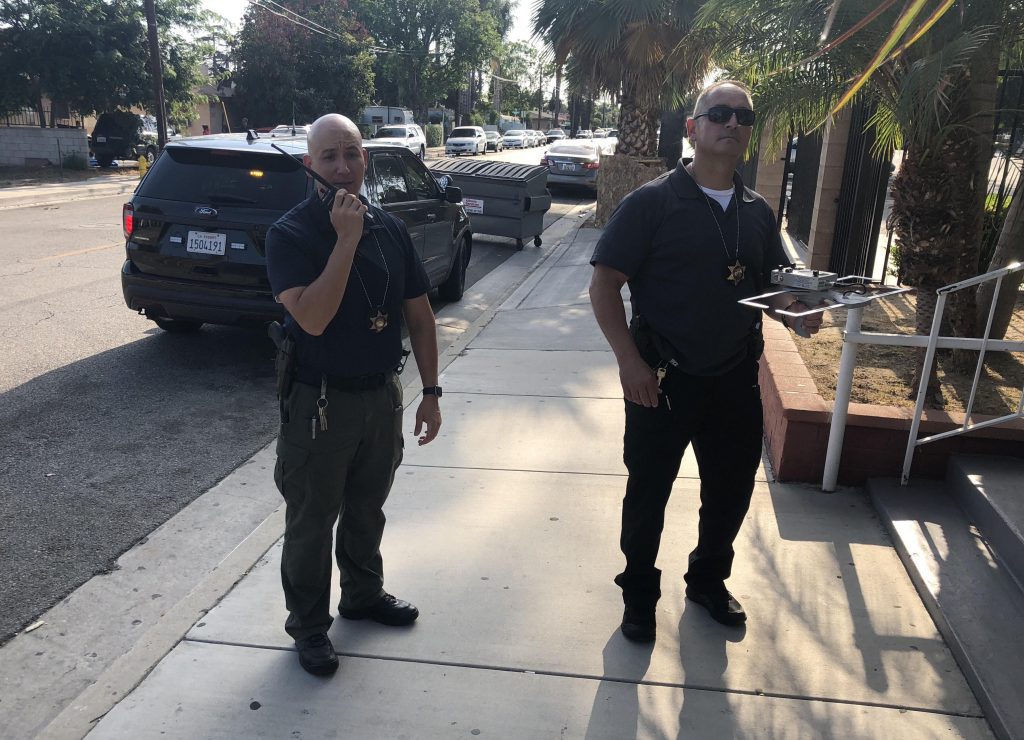
Burbank residents and law enforcement have a new tool for finding missing persons with cognitive and communication disabilities, such as Alzheimer’s, dementia and autism. The Los Angeles County Sheriff’s Department has taken up the mantel of piloting a tracking technology program, Project Lifesaver, for finding individuals wearing the transmitter wristband who wander away in L.A. County.
For those who go missing in Burbank while wearing the Project Lifesaver wristband, Burbank Police can call upon the LASD to assist in locating the missing person.
Over the past several months, the L.A. Sheriff’s Department has been training staff in the use of the tracking technology, including work in the field. More than 12 operators have already trained and six more are currently in training, according to Lt. John Gannon of the LASD Mental Evaluation Team (MET.)
Just last month, in July, seven LASD regional trainers worked directly with Project Lifesaver representatives. Those lead trainers are now instructing other Department members, so the LASD will have a large number of practiced and ready team members to respond to regional deployments and mutual aid requests.
This fall, LASD plans to meet with Search and Rescue teams to train volunteers as Project Lifesaver operators. Gannon anticipates the group of trained personnel within L.A. County to reach more than 50 by the end of 2018. The goal is to provide ample staff from throughout the county to respond when a person wearing the tracking technology goes missing.
“The deputies and DMH [Department of Mental Health] clinicians at the MET enjoy the challenge of using the equipment to locate the hidden transmitters during training,” commented Gannon. “I’ve been very impressed at the level of interest and commitment of our team to embrace this program.”
“I think our personnel are excited at the prospect of helping to locate a critical missing person using this technology. We like helping people and we like problem solving and overcoming challenges.”
“We all chose this profession to help people and there’s nobody we like helping more than our most vulnerable citizens, which this technology is especially well-suited for,” he said. “I think our staff envisions themselves finding that critical lost person who needs us and they take the training very seriously.”
The Project Lifesaver program will officially be up and running by September 5, when the L.A. County Workforce Development, Aging and Community Services Department hosts a press conference. The LASD will be on hand that day with helicopter and ground units for display.
The program has an initial group of 130 transmitters to be issued to qualified low-income individuals with cognitive and communication disabilities in August. Families and caregivers may also purchase the transmitter from Project Lifesaver for approximately $300. All Los Angeles County residents with the transmitter are encouraged to register with the County database.
“There are multiple technologies that complete in this ever-expanding marketplace to help protect senior citizens and persons with developmental disabilities who may wander,” said Gannon. “Virtually any of the technologies available are better than having no protection at all.”
“For some, elopement is a matter of life and death and we have a limited window of opportunity to find missing people before they encounter very real danger. The end result of wandering can be fatal without swift intervention.”
“So, it’s very important for families to consider all options, evaluate the pros and cons of each and find the technology that best meets their needs. No matter which option they choose, your local police and sheriff’s department teams should be able to help bring them back home more quickly if they are properly equipped.”
“For those families who opt for Project Lifesaver transmitters, the LASD is now equipped with receivers, which makes this option viable for those who prefer not to pay annual or monthly service fees,” he added.
While the LASD and some local police departments have received extensive autism communication and de-escalation tactics training, others are still developing training in dealing with those members of the community with communication and behavior impairments.
“We are exposed to autism training through the POST (Police Officers Standards and Training) training videos, both sworn and non-sworn have attended the L.A. DA’s Mental Health Awareness training,” explained Burbank Police training officer, Sergeant Cindy Guillen. “In regards to de-escalation training, there is nothing specific to autism training [for the Burbank Police Department.]”
Finding missing people with autism, Alzheimer’s and dementia is one aspect of the larger interactions of law enforcement and citizens with mental, emotional and behavioral disabilities. Training is essential for successful contact with many at-risk individuals, particularly those with autism and limited communication and cognitive abilities.
“Most people with autism have communication and sensory challenges, but their symptoms are ‘invisible’ – in other words, there aren’t any distinct physical characteristics for someone with autism,” commented Kate Movius, who currently works with LASD on autism communication and de-escalation tactics training. “For this reason, people with autism can easily be misunderstood as being rude, strange or non-compliant.”
“When law enforcement becomes involved, the typical methods used to de-escalate a situation often won’t work for someone with communication and sensory challenges,” she explained. “Providing specialized training for law enforcement gives the officers more tools to use in these types of encounters.”
“We work a lot on non-verbal communication tactics and an overall emphasis on how to slow down and simplify commands and wait for a response from the autistic person.”
Movius has also conducted training for Glendale, South Pasadena, West Covina and Pasadena Police Departments.
“Project Lifesaver provides a potentially life-saving tool for people who wander,” Movius added. “Nearly 49% of children with autism will attempt to wander or ‘bolt’ – often several times. For many with autism, this risk continues into adulthood.”
More information on L.A. County’s new program with Project Lifesaver and details about how the tracking technology works can be found in this previously published myBurbank article.
This article is Part 2 of a two-part series detailing the L.A. Sheriff’s Department pilot program of Project Lifesaver, a tracking technology used to find missing persons with Alzheimer’s, dementia and autism. Families and caregivers who wish to apply for a free transmitter or sign up for the tracking database should contact Veronica Sigala at the L.A. County Workforce Development, Aging and Community Services Department at 213-910-1662.






















